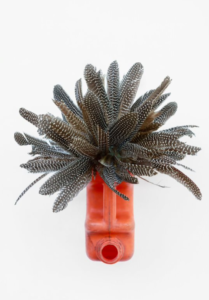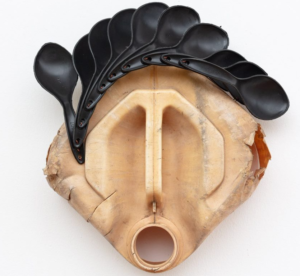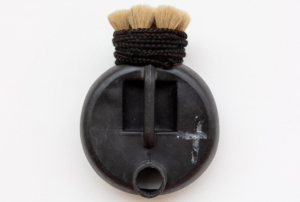
Hazoumè states he isn’t just satirising African politicians. His discourse is focused on international figures who embody global corruption. These masks are a nod at the scandal surrounding the Panama and Pandora Papers, wherein offshore wealth was also “masked” by the elites.
Romuald Hazoumè in conversation with Christabel Johanson
Kind of Blue, 2021. Found Objects, 38 x 55 x 18 cm, Copyright R. Hazoumè,Courtesy the Artist and October Gallery, London
First published: October 4, 2022
Romuald Hazoumè: Carnaval
Romuald Hazoumè’s fifth solo exhibition in London opens this October. Entitled Carnaval, Hazoumè returns to his signature masks; “masque bidons” or repurposed masks. Within the show the artist is said to observe “international concerns and the figures that populate the world’s political stage.”
The Benin-native has exhibited internationally in galleries and museums across the world including across London, Europe, America and Asia. His interest in contemporary African art revolves around political corruption and he is known for his Mask Series.
In Carnaval, Hazoumè fashions his masks from found objects with an intention to give new life and a different meaning to the materials. The novel interpretations reinvigorate not only the items but combine to form brand new signifiers for the masks.

Pintade, 2022,Found objects 45 x 43 x 35 cm, Copyright R. Hazoumè,Courtesy the Artist and October Gallery, London
However the artists insists that the masks “in no way resemble those originally powerful African masks used for ceremonial purposes. Whereas such artefacts exist as mysterious power objects, each of my ‘masks’ portrays a real-life individual or even a distinct personality type.” To this end, some of the masks allude to specific figures such as African political heads but the enjoyment and mystery of using masks is their ability to hide the truth in a creative and satirical way. It can be a perpetual guessing game.
The mask tradition is something I have covered in previous issues however it is worth noting that the African tradition of masquerade is steeped in a history of mockery and ridicule of the personalities portrayed. What is said to be a “topsy-turvy” space within carnival allows the marginalised to don these masks and make fun of the status quo. It is a space of mischief and the subversive; a space where one’s identity is hidden and warped through use of masks. It is said that “Truth speaks openly and directly to Power”, meaning that the norms of etiquette, or the stronghold of power that silences free speech is no longer in play.
The power of mockery cannot be underestimated. Laughter is an equaliser because it takes away the fear of the subjugated and takes away the control of the dominators – even if only for a minute. Satire, carnival, masquerade all operate on this currency that is constantly in exchange. If we can laugh at the people and situations that rule over us, then are they so scary after all? When we invite others to laugh at them too, then we are all conspiring against the status quo and suddenly we find ourselves united even for a brief moment. In a world that often feels overwhelming, divided and out of our control, one of the few things we can control is our perspective. No one can stop us from laughing.

Napo, 2022, Found objects 43 x 41 x 14 cm, Copyright R. Hazoumè, Courtesy the Artist and October Gallery, London
Carnaval can be read as a play of sorts because the archetypes who inspire the masks are thought of as actors. Hazoumè strongly includes African heads of state as part of the “actors”. I also interpret these people as puppets in some ways. Whether actors or puppets, the characters are playing a part and the criticism Carnaval imparts is that the elites are hiding truth, wealth and privilege from 99% of the population.
Yet Hazoumè states he isn’t just satirising African politicians. His discourse is focused on international figures who embody global corruption. These masks are a nod at the scandal surrounding the Panama and Pandora Papers, wherein offshore wealth was also “masked” by the elites. So the theme of masking appears again and again. The elites mask their affairs in real life and in the world of Art Hazoumè uses masks to unveil these characters.
What was your inspiration for producing Carnaval?
My inspiration starts from an observation: the politicians who govern our nations are for the most part actors. The idea of making portraits of them came to me right after the pandemic. But it’s not just portraits of politicians.
There is an obvious political reading for the masks. How hard or easy did you find it to “conceal and yet reveal the hidden identity of their subjects”?
I can assure you that it is not easy to make a good portrait of them. Politicians have physical traits and nicknames given by the people they govern. But there is one thing they cannot hide – their true face, which they end up revealing.
With its wink at the subversive, how relevant do you feel this exhibition is during our current political climate?
The relevance of this exhibition remains with the questions that are asked while visiting the exhibition when the viewer tries to find out who the mask is. I bring humour to visitors by relaxing them a little in the face of this tense period, where unfortunately war has returned to our very doorstep.

Romuald Hazoumè, Photo © Jonathan Greet
How do you want the public to feel when they view your work?
When they read the titles, the onlooker can guess the character and laugh. Sometimes it’s not funny when they find the character whose portrait is made. It may remind them of dramatic things. The most important thing for me is to use the power of laughter, as to laugh allows resilience.
There is a connection between the mask-wearing and African traditions, yet you have stated that yours do not resemble traditional ceremonial masks. Would you like to comment further on this disassociation and why you highlight it?
Yes, I can confirm that my masks do not seem to resemble African ceremonial masks because they do not have the same spiritual connotations. They are simply not sacred in the same way as African ceremonial masks are. But they are made for the same community and talk about the problems of their time, so today they are in their way sacred, (without carrying the spiritual notions) because they convey important messages that help the same community.
How would you describe the meaning of “carnival” in your own words?
Masquerade, buffoonery, lies, seller of illusions, etc. … all these words describe the Carnaval I am talking about.

Blaireau, 2022, Found objects 34.5 x 26.5 x 10 cm, Copyright R. Hazoumè, Courtesy the Artist and October Gallery, London
There is something tangible, powerful, and primal in masks. How conscious are you of their size and other details when creating them?
It takes the right words to express the power of masks that many of us perceive/grasp when we look at them; whether we belong to the community where they are used or not, we notice the power. In my case, my work takes a lot of time for the result that you finally see. Being a dead object, that is to say, part of the waste of consumer society, the mask is a force and I can assure you that I am not solely responsible for this act. Society puts its own input and time too. I am well aware that all these details make the MASK.
Why do you feel this artistic expression of masks has been continued throughout history for so long?
The mask cannot be separated from the human being. The mask is the true face, it is worn by all humans, it serves to protect oneself; it allows one to communicate, it unites and also creates differences. It speaks, transmits the past and present from generation to generation. Those who tried to destroy the religions they (the masks) served, protected them in their museums. It is simply for all this that masks will remain so long in our lives.
How important do you think it is to preserve this particular thread of history?
The responsibility lies with Africans. They must not forget where they come from, their history, their cultural heritage.
What are you working on next?
I work on Man.
